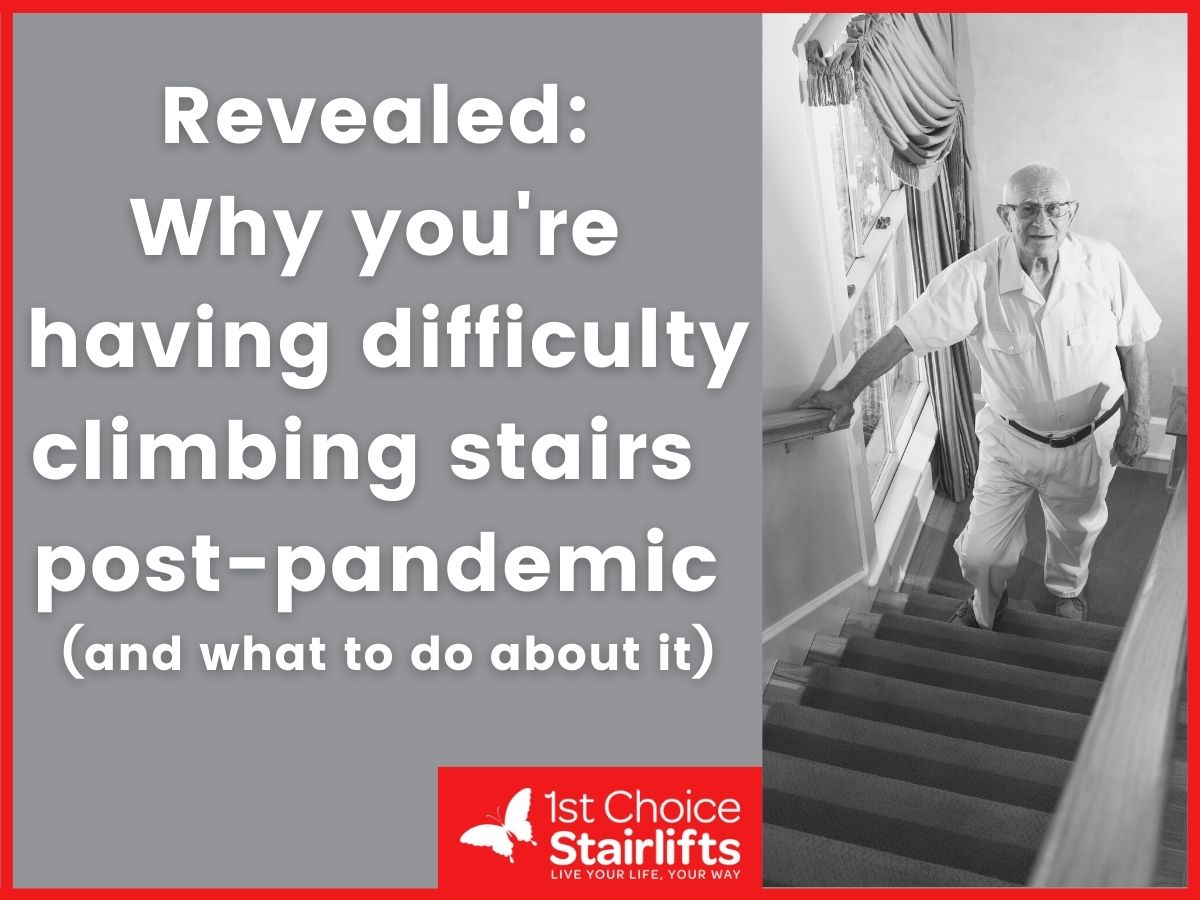It’s estimated that we take around 250,000 journeys up and down our stairs in our lifetime, so it’s perhaps inevitable that over time, we might start to experience difficulty climbing the stairs as we get older.
However, in May 2021, Age UK reported findings from its recent study that assessed the effect that the Covid pandemic has had on older people. It revealed that 1.2 million people over 60 years old who had difficulty walking up and downstairs before the first lockdown find it more difficult now. Also, around 1.6 million people now have difficulty with the stairs when previously they did not.
People’s mobility has declined due to Covid restrictions meaning that we have spent more time in our homes instead of going out and about and exercising. So if you feel you are struggling with the stairs then you are one of many people who are experiencing the same issues.
Why is climbing the stairs so hard and so tiring?
As well as the pandemic exacerbating the situation, as you age your mobility can change. You tend to lose muscle strength and bone density which reduces your flexibility. You can also have problems with balance and vision, depending on your health conditions.
Exercise can help to boost your health, mobility, and movement, and whilst there are lots of fit over 60’s, there are also people who can’t exercise, through no fault of their own, because of health conditions.
Many health conditions can make climbing the stairs difficult. These can be conditions such as arthritic knees and hips that can be painful when walking up and downstairs. You may have osteoarthritis or osteoporosis that affects your gait and balance making you unsteady and bent over. Conditions like chronic obstructive pulmonary disease or COPD as it is more commonly known as can cause breathlessness when climbing stairs. These conditions can lead to longer-term disabilities which can worsen over time.
If your condition means that you are using crutches, walking sticks, or other walking aids to get around the house or go up and downstairs you probably need to start thinking about a safer way of getting up and down.
Does climbing the stairs help with exercise?
Often people think that climbing the stairs can help with exercise and whilst that may be true for most people, if you have mobility difficulties exercising on the stairs can cause health and safety risks.
What injuries can you get from falling down the stairs? Bumps, bruises, broken or fractured bones, and even death! The stairs in your home are where the more serious accidents happen and according to RoSPA the Royal Society for the Prevention of Accidents, 60% of over 65’s are likely to die as a result of having a fall on the stairs. A really scary statistic I’m sure you will agree.
How do you climb the stairs if you have mobility problems?
Often if you are having trouble climbing the stairs, you may carry on struggling needlessly for quite some time before asking for help and looking for a solution. You may climb stairs one foot at a time, go up sideways and haul yourself up using handrails or banisters, go up sideways, on all fours, or even on your bum.
Even worse we have seen carers, often the spouse helping the husband or wife upstairs by walking and pushing them up the stairs. If a fall were to happen the spouse/carer would also get hurt leaving no one to care for their loved one.
All these ways are not ideal and can cause excessive strain on your body and falls risks are increased. So what can you do to solve this problem, help your health and reduce the probability of having a fall on the stairs?
What is the solution to Stair Climbing difficulties?
So if you are wondering why am I having difficulty climbing the stairs and what can I do about it, several solutions might help you including:
Installing a second handrail
When you start to struggle with the stairs a second handrail on the opposite side of your stair banister might help. This can be a good interim measure if you are having a little difficulty and not too much of a struggle. You will have the aid of two handrails to help with your balance to hold onto. However, if you have to haul yourself up the stairs then it will put unnecessary pressure on your shoulders and back and could do you more harm than good.
Installing a stairlift
The easiest, cheapest, and most popular solution is to have a stairlift fitted. A stairlift is a reasonably quick adaptation to your home that can be installed in just a few hours and will be a safer way of using your stairs. If you have other people that need to use your stairs, such as your spouse or carer, for example, the lift chair will fold up out of the way to let them have access to the staircase. The rail of the stairlift stands on brackets and they are screwed to your stair treads so you don’t need to worry about any redecoration or damage to your walls.
Installing a Home Lift
If you want to keep your stairs clear and you have enough space in your house, you could consider fitting a vertical small passenger style lift in the corner of a room – usually in a living room raising through the floor to a bedroom above. This involves builders’ work to cut a hole in the ceiling and reinforcing the joists. This job can be done with the installation in around 4 days.
Converting your Existing Home
You could also move your bed downstairs and live on the ground floor, although this is not ideal and effectively turns your house into a bungalow. It can also devalue your house if you alter the downstairs to accommodate a second bathroom and bedroom.
Moving House
You may also consider moving house but there is no need to leave the house you love just because stairs are a problem – not you. The average house move in 2021 is estimated to cost around £9000 not to mention the undue stress and upheaval, having to pack and perhaps get rid of much-loved possessions to downsize.
Summary
So there are lots of reasons why you might be having difficulty climbing the stairs and you are not alone. Although we don’t like to admit defeat, asking for help climbing the stairs will make life so much easier.
Having a stairlift fitted can make such a massive difference to your independence and keep you safe, alleviating the fall risks and giving peace of mind to loved ones.
There are hundreds of thousands of stairlifts fitted every day and having problems climbing the stairs that can be easily solved by this common solution which is becoming increasingly in demand. Even as a small independent lift company that operates within a 2-hour radius of our office in Calne, Wiltshire, we sell around 500 stairlifts every year mainly through personal recommendations and we don’t even advertise!
Simple adaptations like having a stairlift fitted have been found to keep people independent in their own homes and delay the move to a care home by up to 4-7 years, as shown in a recent study.
If you are wondering whether or not you need a stairlift fitting, take a look at our “10 signs that you might need a stairlift fitted” article. For fall prevention advice, visit our “Avoiding Falls on the Stairs” and download our free “Preventing Falls Around Your Home” leaflet.
If you’d like to talk to someone and take the first step to solve your stair climbing problems, please give us a call for a friendly chat on 0800 019 22 10. We’re not into hard selling and you are under no obligation, we’re just here to understand your problems and offer helpful expert advice.
We cover Wiltshire, Bath, Swindon, Bristol, Hampshire, Dorset, Berkshire, Oxfordshire, and Gloucestershire so please get in touch if we can help you.










